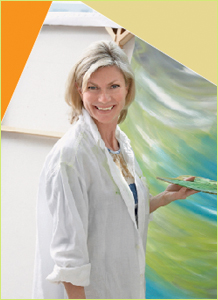Go from chaos to calm by engaging in creative pursuits—from knitting to dancing to painting.
Kids have it right: To blow off steam, they finger paint, dance, sing, and draw. But when grown-ups need to de-stress, we often forgo creative pursuits. But dabbling in the arts is a fun, long-lasting way to combat stress—and even to head it off before it happens.
The Zen of art
One of the hallmarks of creativity is a state of consciousness called "flow," according to Robyn McKay, Ph.D., a therapist and creativity researcher in Tempe, Arizona. Flow helps you relax—it's what happens when your skills are engaged in a task that's challenging but not so difficult as to be frustrating. This may be writing a short story or cross-stitching a picture. "Flow is an optimal experience," explains McKay. "It's characterized by being in the zone and a sense of timelessness. There is a lack of self-consciousness, and you become really absorbed in the activity." McKay says that there is less activity in the brain when you're in a state of flow, so your mind actually gets a much needed rest from the stresses of the day.
Somewhat related to flow is mindfulness, a focused attention on what you're doing moment by moment, whether it's doing the dishes or photographing a sunset. Mindfulness has the same stress-relieving benefits as meditation, and engaging in art is a wonderful way to practice it. "When we focus our attention through creative activities—or in meditation—we see a decrease in heart rate, a decrease in respiration, and even, over time, a decrease in stress hormones," says McKay.
Switch it up
Engaging in art can also help you work through problems that are stressing you out by giving your logical left brain a break and turning the issue over to the more intuitive and creative right brain. "Art forms tend to open up the right side of the brain, which allows for a more unconscious release of emotions and energy," says Erik A. Fisher, Ph.D., a psychologist in Georgia and author of The Art of Managing Everyday Conflict: Understanding Emotions and Power Struggles. "When we switch things up by using the right brain instead of the left brain, that sometimes is a way to work out stress."
According to McKay, tackling a new, creative task not only gives your right brain a chance to shine, it also gives your brain a chance to think about something other than your stressors. For example, if you spend all day dealing with angry clients as a customer service rep, engaging in an art form like playing the piano in your spare time gives your mind something new and refreshing to mull over besides work. Even people with creative jobs can benefit from this. For instance, McKay might suggest that a professional writer "cross train" by painting in her spare time.
Get your art on
Want to get started with a creative pursuit? Anything that catches your fancy will do: Consider dance, painting, drawing, photography, writing, sculpting, knitting, or playing music. If your aim is to release pent-up tension, Kate Siner Francis, Ph.D., a psychologist and artist in Providence, Rhode Island, suggests choosing an art form that lets you be physical. For example, opt for a fast dance style, make a giant sculpture instead of a tiny one, and rather than painting small watercolors, get a large canvas so you can move around and splash on color.
If you're not sure how to get started with your chosen art form, consider learning from the pros. Lessons are available in all price ranges, from Chinese brush painting classes at the local adult education center (cheap) to private instruction from a professional artist (not so cheap). Check the Internet and your local Yellow Pages to see what's available near you.
Art is a great way to keep free-floating, everyday stress at bay, but it's also useful for banishing acute stress, say if you're worried about giving a presentation at work. Fisher recommends using whatever creative pursuit you choose to work out your feelings on the issue. For example, if you're painting, you can make expressive strokes and choose colors and shapes that reflect how you feel about the situation. If you're dancing, you can act out your feelings with your movements. On the other hand, says Fisher, you can also use your art to create an escape from the stressor: Paint a calming landscape or dance to soothing classical music.
Finally, don't let a fear of failure keep you from trying out a new art hobby. "No pressure, that's the number one thing," says Siner Francis. "People often think that if they are going to do something, it has to come out right. Just allow it to be and know that it is a process and that you'll grow if you do it." The more you practice, the better you'll get—and the more you'll beat stress.




